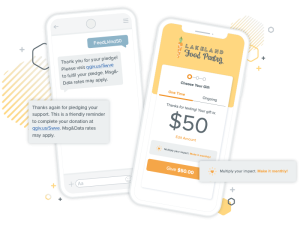Peer-to-peer fundraising is a strategy that empowers your donors with fundraising tools and personalized fundraising pages to raise money on your behalf. Through peer-to-peer fundraising, your organization is able to tap into a supporters’ existing social networks to increase community awareness of your cause and expand your donor base, as nearly 40% of Americans have given to a nonprofit because of a friend or family member’s request.
Let’s dive into peer-to-peer fundraising and how it can help your organization!
- What is peer-to-peer fundraising?
- Top 5 peer-to-peer ideas
- Steps to getting your peer-to-peer campaign started
- Peer-to-peer fundraising best practices
- Using peer-to-peer fundraising software
- How Qgiv can help your peer-to-peer fundraising campaign
- Peer-to-peer fundraising FAQs
What is peer-to-peer fundraising?
Peer-to-peer fundraising is a type of fundraising that provides your supporters a way to raise money on your behalf by allowing them to create their own personalized fundraising campaigns that they use to appeal to their personal networks for donations.
There are different styles, but peer-to-peer fundraising can support individual fundraising, team fundraising, or a mix of both. Your nonprofit can use peer-to-peer campaigns to encourage participation in an event, get supporters involved with your mission, and raise more money!

How does peer-to-peer fundraising work?
Peer-to-peer fundraising can seem complicated, but here are a few simple steps to help get you started:
- First, you’ll set a fundraising goal and set up its main campaign page using a peer-to-peer fundraising platform.
- Then, you’ll recruit volunteer fundraisers to set up their own individual fundraising pages.
- Next, you’ll provide your participants with resources to use while promoting their pages.
- During the fundraising stage, fundraisers will share their individual campaign pages on a variety of channels.
- Throughout the fundraiser, you’ll track the campaign’s progress and offer continued support to the volunteer fundraisers.
- Lastly, you’ll thank your supporters immediately following your event to show your appreciation for their help.
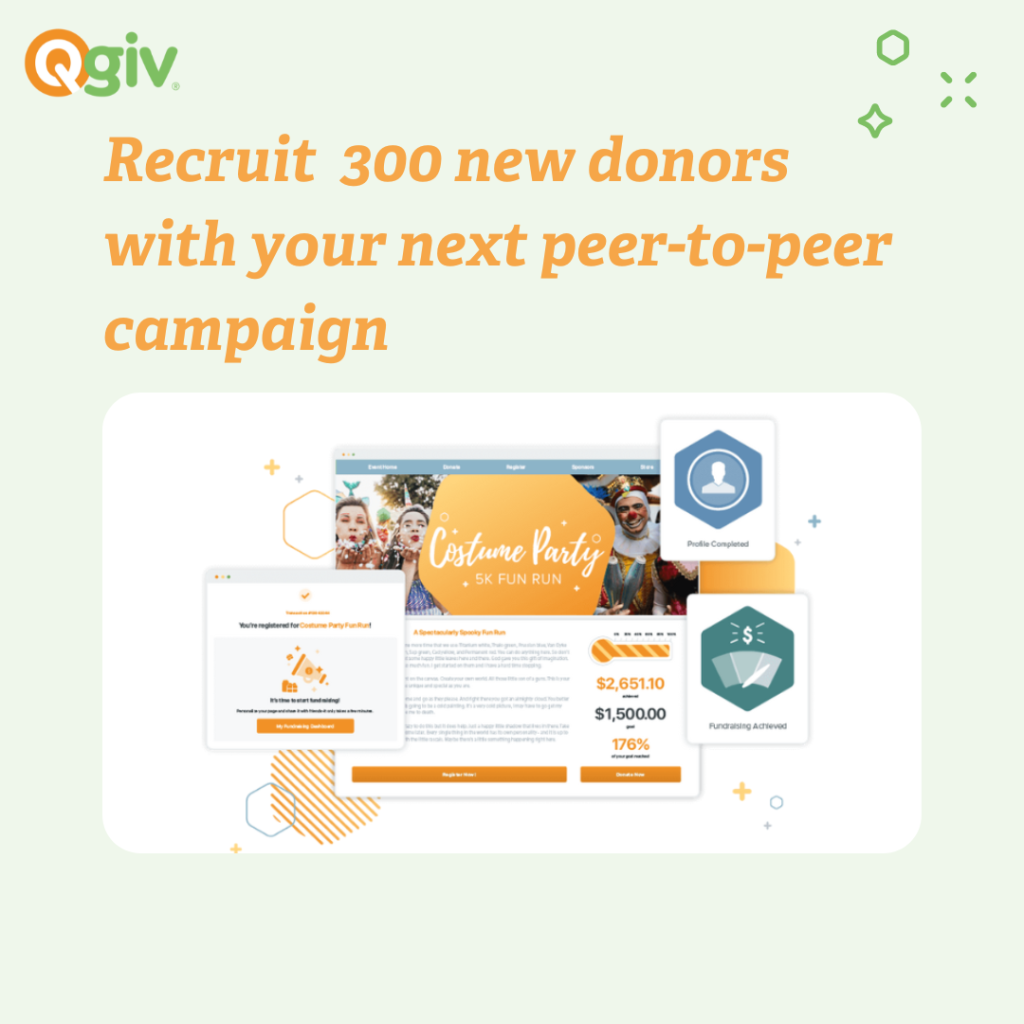
Benefits of peer-to-peer fundraising
While there are many benefits of peer-to-peer fundraising, one of the most noteworthy is how effective this method is for finding new donors. According to data pulled from Qgiv’s platform, organizations recruit 300 new donors on average using peer-to-peer campaigns. And even if not everyone in your participants’ networks donate, you’re still raising more awareness for your cause and mission. Plus, it offers volunteer opportunities to keep previous donors engaged with your organization.
Types of peer-to-peer campaigns
With the many ways to host a peer-to-peer fundraiser, it’s important to remember your campaign doesn’t have to be an event. Different peer-to-peer fundraisers include:
- Virtual peer-to-peer
- DIY fundraisers
- Network fundraisers
- Events
- Team fundraising
- Rolling campaigns
- Time-based campaigns
Top 5 peer-to-peer fundraising ideas
While there are many peer-to-peer fundraising ideas you can use, here are 5 common peer-to-peer fundraisers featuring some of our favorite examples!
1. Walkathons
Walkathons and other fitness challenges are some of the most popular types of peer-to-peer fundraising and probably the one you’re most familiar with. One of the best parts of walkathons is that you can theme them to match your organization’s cause! One of our favorite examples is the Pikes Peak Humane Society fundraising campaign, which is part of their annual Pawtoberfest event that they have continued to hold over the years.
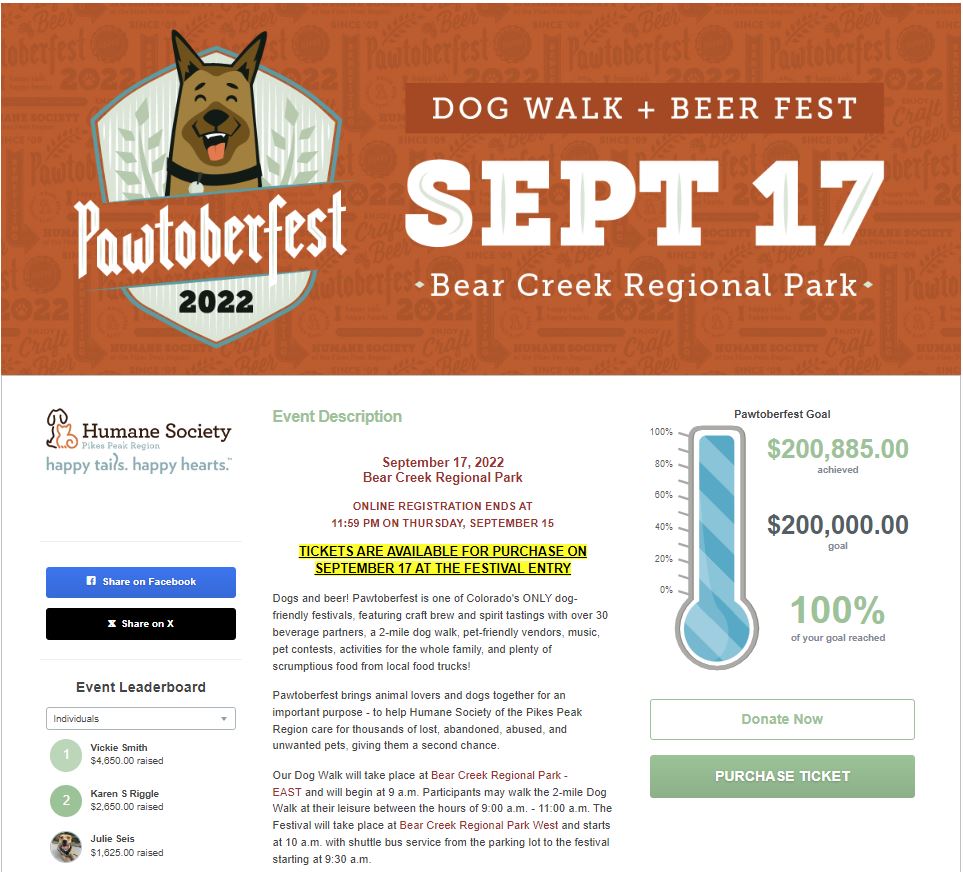
Here are some key aspects that makes this campaign work:
- Bright and varying colors
- Branded header image
- Clear event description
- Fundraising thermometer
2. Network fundraiser
Network fundraisers are a simple way for your supporters to raise money for you that doesn’t require a big event. These fundraisers allow your supporters to sign up and fundraiser by reaching out to their personal networks in a way they think will be the most effective while spreading the word about your cause to like-minded people.
3. Scavenger hunts
Scavenger hunts are a fun way to get your supporters excited about fundraising on your behalf. This type of peer-to-peer fundraiser utilizes people’s competitiveness to raise more for your cause. A great example of this fundraiser is Junior Achievement of Arizona’s 2021 Virtual Scavenger Hunt.
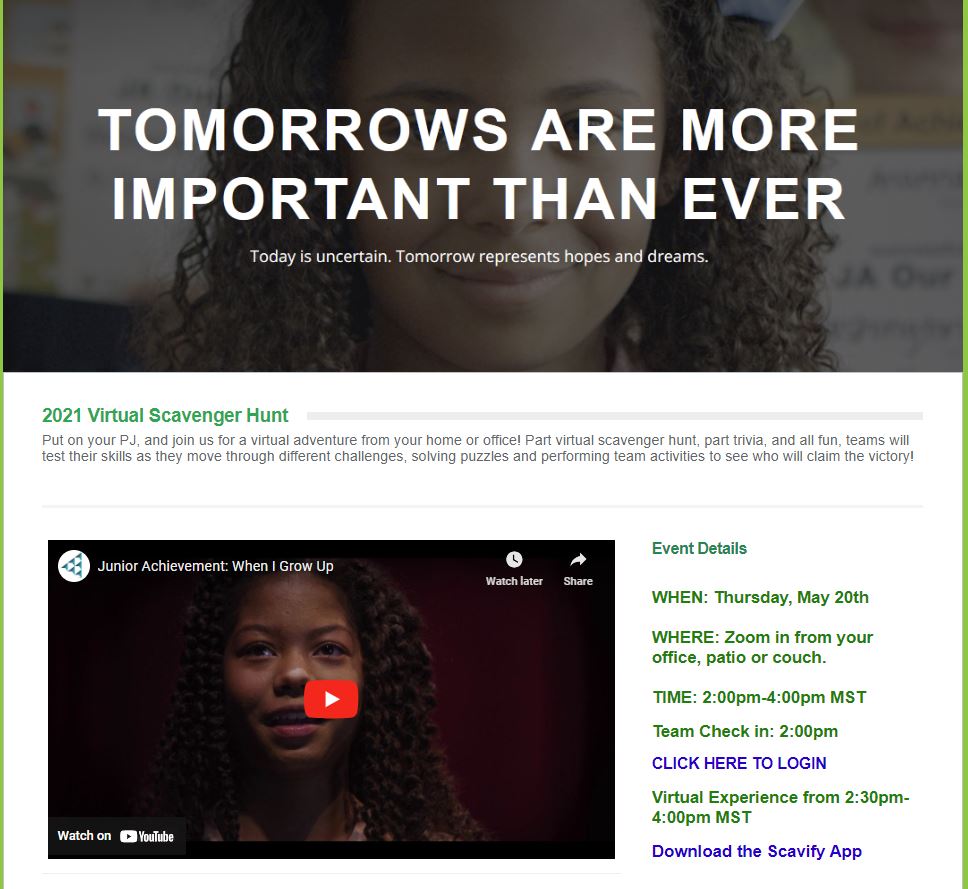
Here are some key aspects that makes this campaign work:
- Impactful header image
- Recent activity
- Embedded video
4. Social media challenges
Social media challenges take advantage of the trends that circulate the digital world. Your supporters can take a picture or video of themselves completing the challenge to help them ask for donations, as well as challenge others to participate as a fundraiser themselves. These challenges are especially good for raising awareness for your mission.
5. Team sports
Team sports are another common peer-to-peer fundraising idea you can use to raise money. While many peer-to-peer campaigns focus on individual participants, joining a team can help motivate supporters to participate in the campaign. One example of this fundraiser that we love is Big Brothers Big Sisters of Greater Cleveland’s Bocce for Kids’ Sake that both individuals and teams could sign up for.
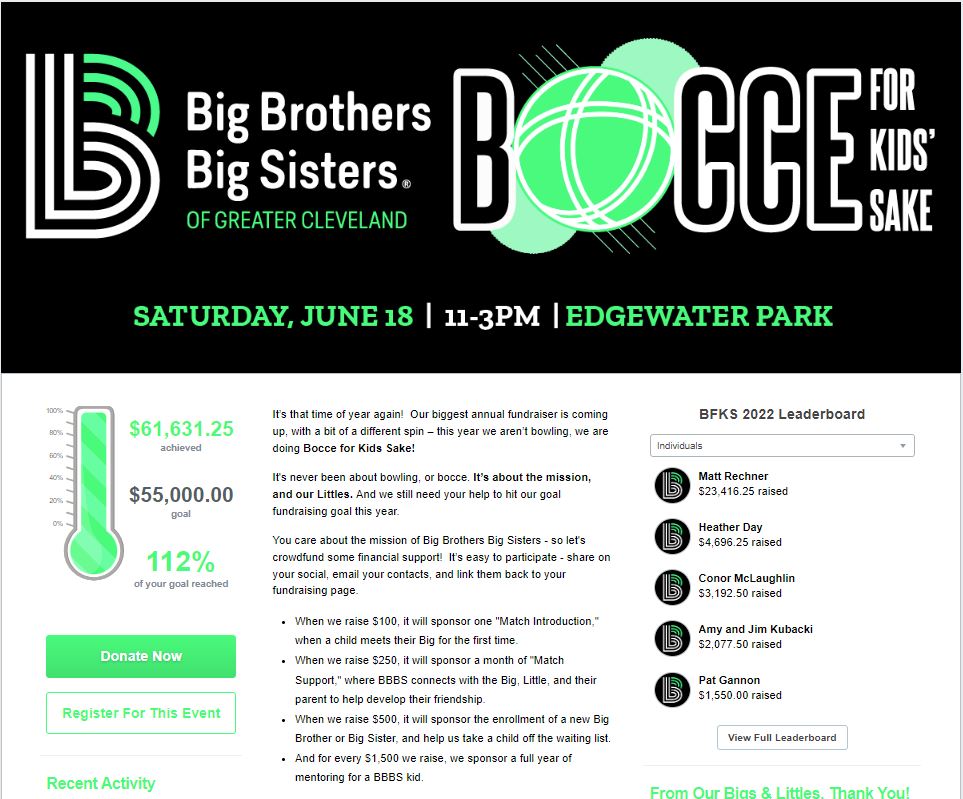
Here are some key aspects that makes this campaign work:
- Unique and fun activity
- Fundraising impact statements
- Leadership board
- Event information in header
Steps to getting your peer-to-peer campaign started
By now, you’re probably asking yourself, “How do I start?” Well, here are all the key parts of the planning and execution into seven simple steps!
1. Define your campaign
Once you’ve decided to run a peer-to-peer fundraising campaign, ask yourself:
- How much do we want to raise?
- Which kind of campaign is this—rolling or time-based?
- What’s the central theme?
Create a campaign checklist of what needs to be done and what you want to complete for your campaign. Setting your goals is a great way to keep everyone on the same page and ensure that you’re on the right track throughout your fundraiser.
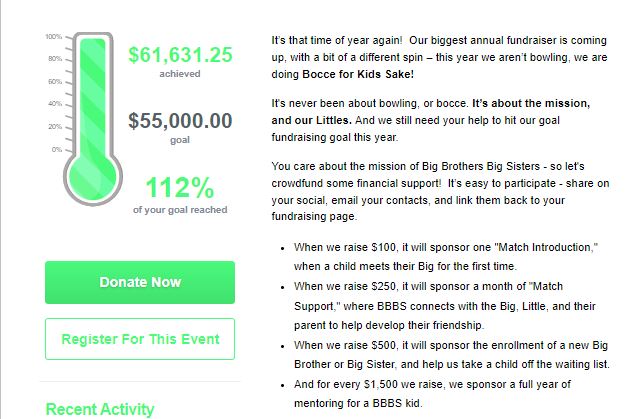
2. Recruit your fundraisers
Once you’ve figured out your goals, it’s time to reach out to your donors and volunteers to recruit participants for your peer-to-peer fundraiser. Here are some ways to start recruiting:
- Send out emails and post about your campaign on your social media accounts to grab people’s attention and get them excited to fundraise.
- If you’ve hosted peer-to-peer campaigns in the past, extend a special invitation to past participants to see if they’re willing to fundraise again.
- Offer incentives for people to become fundraisers, including free t-shirts and other prizes as well.
The sooner you start reaching out and spreading the word, the more participants you’ll be able to recruit!
3. Set up your campaign website
The bulk of your peer-to-peer campaign revolves around the campaign page you create. This will be the template from which your participants will create their individual fundraising pages. Your campaign website will be the go-to resource for all of your participants, donors, volunteers, and anyone else involved in your fundraiser.
Choosing the right peer-to-peer software can help take some of the stress off of this step. A good peer-to-peer fundraising software should have customizable pages and tools, like fundraising thermometers, to help you create a compelling campaign page.
Here are a few tips and tricks to create an eye-catching, informative, and helpful page for your next peer-to-peer campaign:
- Create an FAQ page. If you can anticipate common questions your fundraisers will have about peer-to-peer fundraising, the specifics of your campaign, or anything else, creating an FAQ page can give your participants, donors, and volunteers a place to get answers.
- Use cohesive branding. Display your logo prominently on your website and stick to a nice color scheme that reflects your organization’s branding or specifically created for your campaign.
- Include a fundraising thermometer. Displaying your fundraising progress on your website helps people visualize how well your campaign is going. It also helps your donors feel proud about their contribution to your fundraiser’s success.
Step 4: Facilitate donation pages
Before your campaign starts, educate your fundraisers on how the campaign works, what your goals are, and how to use the fundraising software. To get them started on the right track, here are a few ways to help each participant design and personalize their own donation page:
- Give your participants writing prompts, talking points, graphics, and anything else they might need to create an engaging and effective fundraising page.
- Then, after they’ve built their pages, ensure your fundraisers have everything that they need to share their donation pages.
- Provide them with access to social sharing buttons, post templates, and ways to sign up to be a volunteer or purchase merchandise.
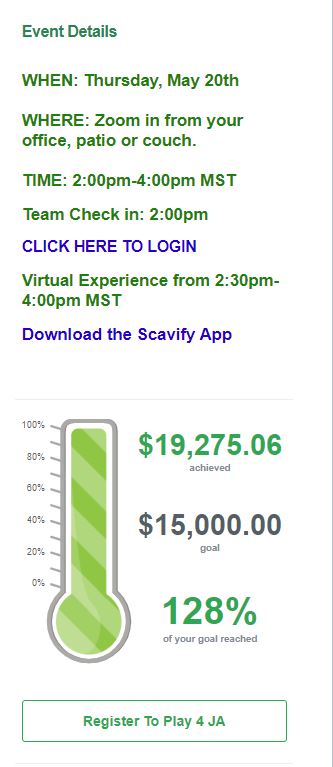
5. Support your supporters
Chances are your peer-to-peer participants don’t have much experience with fundraising and asking for donations themselves. While they may have experience with being on the receiving end of a donation appeal, they probably don’t have any experience making that kind of request. Before you send your participants off to ask for donations, fully equip them to start fundraising:
- Provide your fundraisers with email and social media templates, scripts, graphics, and storytelling tips and tricks so they can put their best foot forward when making a donation ask!
- With these kinds of resources, all your participants need to do is fill in the blanks and send their well-crafted message off to their family and friends.
- And as a well-seasoned fundraiser yourself, guide them along the way with advice and tools you may use when fundraising!
6. Build relationships with your donors
As donations come in, you’ll need to keep track of your fundraisers’ efforts and collect new donor data by:
- Syncing new donor information to your CRM
- Updating your existing donor database records
- Linking donation and interaction history with your supporter profiles
Afterward, use that information to update your donors and participants about your progress. Running a peer-to-peer campaign will help you form deeper relationships with your donors and fundraisers, but you need to stay engaged with your supporters throughout the process!
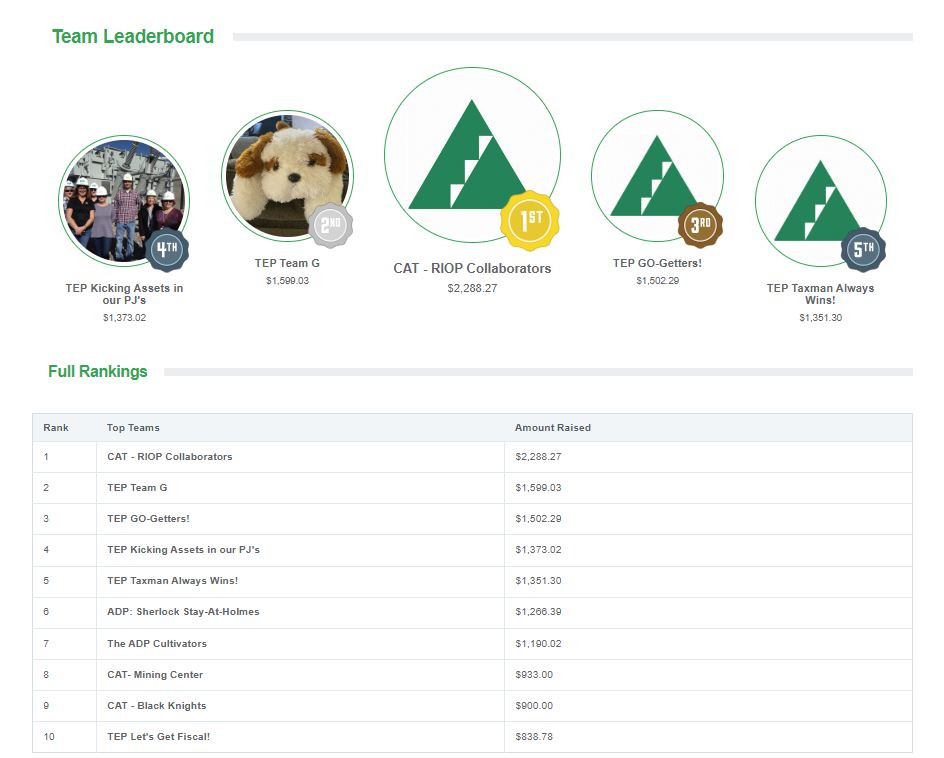
7. Recognize your peer-to-peer fundraisers
Once your campaign is over, you should recognize your participants for their work. Here are a few ways to show your appreciation:
- Thank each and every one of your peer-to-peer fundraisers with a personal note, social post, email, or phone call.
- Use your end-of-campaign event to celebrate and recognize them, too!
- Let them know how much you appreciate their help and tell them what their fundraising has achieved.
- Then, follow up with your donors and fundraisers alike to share how you used the money they raised.
Peer-to-peer fundraising best practices
Wondering how you can step up your peer-to-peer game? Here are a few best practices all seasoned fundraisers keep in mind when running a peer-to-peer campaign.
1. Provide a simple donation page
Donation pages can drastically affect your donor conversion rate. The way your forms are set up and how quickly they load can be the difference between a new donor and a lost opportunity. Conversion rates drop by 4.42% on average for every extra second of load time. Provide a simple and quick donation page for donors to fill out and complete as easily as possible.
2. Use multi-channel marketing
Once you’ve recruited your team of fundraisers and prepared them to raise money, how can you help them spread the message about your campaign?
Multi-channel marketing can help you and your peer-to-peer participants reach more of your donors and even expand your reach beyond your usual network! Some effective ways to use multi-channel marketing to spread the word about your peer-to-peer campaign and solicit donations include:
- Email: Email is one of the most effective methods of asking for donations during this kind of fundraising campaign. Try providing your fundraisers with a few templates they can fill out and use to email friends and family about your campaign and their fundraising efforts.
- Social media: Facebook, X, Instagram, TikTok, and LinkedIn are all popular platforms your supporters are probably already using! By providing ready-made templates for different platforms, you make it easier for donors to maximize your posts. Sharing personal fundraising pages on social media brings them to the attention of your fundraisers’ friends and family.
Encourage your participants to post updates that share why they’re participating and ask people to give. Once they’ve started posting, interact with their posts by liking or commenting to drive engagement and make your participants feel heard.
- Traditional marketing: Ask for donations yourself, too! Direct mail, print advertisements, and face-to-face solicitations are great ways to engage donors who aren’t online or prefer more personal interactions.
Your participants can also solicit donations in person when they get together with their family and friends or by hanging up flyers in their communities. Provide your participants with scripts they can use to ask for donations when they’re fundraising face-to-face with others.
- Text marketing: Reach your supporters no matter where they are using text marketing. Send out campaign notifications and updates straight to their phones, along with a link to your donation form. Provide a keyword for supporters to text to donate to your fundraiser.
- Blog: Maximize traffic to your campaign website by writing blog posts about your peer-to-peer campaign. Show examples of people you’ve been able to help using money raised from previous fundraisers.
- Local media: Reach out to local media outlets, such as news channels and radio stations, about sponsoring your peer-to-peer campaign. In exchange for them advertising your campaign, you can promote them on your fundraising page or event.
3. Integrate with matching gifts platforms
Encourage your supporters to participate in their employers’ matching gift programs! Every donation made by an eligible donor can be matched at a 1:1, 2:1, or even 3:1 ratio. This means a single donation can have double the impact!
But how do you make it happen? Just provide your donors with access to a matching gift database like Double the Donation! Matching gifts databases give donors a way to see if their gift is eligible for a match within your donation form. They can also review their employer’s matching gift requirements!
Add a matching gifts widget to your donation form so your donors don’t even have to leave the page to check if their employer has a matching gift program. Adding this widget also makes the matching gift process easier for their employers. Once your donor completes their gift, their donation information is automatically sent to their employer for processing.
Many companies have a minimum amount they will match. If your supporters know this, they may be inclined to make a bigger donation! Imagine a donor was going to donate $15. Then, during the donation process, they learn their employer only matches gifts of $25 or higher. That donor will likely donate $25 so their gift can be matched, meaning you can receive $50!
4. Stay engaged with your fundraisers
Once your fundraising campaign is in full swing, stay in contact with your fundraisers by:
- Sharing frequent campaign updates
- Acknowledging and celebrating the most successful fundraisers
- Encouraging hesitant participants
- Engaging with your fundraisers’ posts
Motivate your fundraisers and play to their strengths! Strengths may include a strong, engaged social media following or a close connection with locals in your community. Help them use those assets to raise money!
5. Use cohesive storytelling tactics
As you send your participants off into the world to fundraise for your organization, keep everyone on the same page about the messaging of your campaign. Ensure that all facts and figures you’ve shared with your participants are accurate and that the tone of your campaign is cohesive.
While it’s okay to tailor messages specifically to your audience and for your participants to do the same for their audiences, it’s important that the main points of your campaign are the same across every email and social media post you or your participants create and share. This avoids confusion and instills confidence in your donors that they’re donating to the right cause.
6. Make it easy for your participants to share
Your participants will frequently share their personal fundraising pages and information about your peer-to-peer campaign with their audience once the fundraising gets started. To avoid forcing your participants to copy and paste the same information and links over and over again, add social sharing buttons everywhere you can.
With a single click, your participants can share their personal fundraising pages, your campaign website, and any other important pages with their networks via email or social media. And with templates and scripts, crafting the perfect post shouldn’t take more than a couple minutes. Use any tools you can think of to make sharing about your campaign easier for your participants.
The more they’re able to share your campaign, the wider within their networks you’ll reach. And with that wider reach comes more potential supporters for your cause.
7. Encourage friendly competition
Motivating your participants is easy when you introduce a little friendly competition into your campaign! Offer prizes to the people who raise the most money by the end of your fundraiser or reward them with badges every time they hit a fundraising milestone.
You can also allow participants to team up with their friends, family, or coworkers by creating fundraising teams. Fundraising with friends is always more fun, and setting out to conquer other teams as fundraising champions is an extra-engaging element you can add to your peer-to-peer fundraiser. Just make sure to add a team leaderboard to your campaign website so everyone can see where they stand and how much money they need to raise to reach the top spot!
8. Inspire your participants
Do your fundraisers need an extra push or motivation to keep fundraising? Prizes are a great way to incentivize your participants, but there are plenty of other ways to keep them engaged and inspired.
Use your organization’s social media platforms to give them a little morale boost. Have any of your fundraisers shared a particularly moving reason for why they support your organization? Has anyone gotten creative with their fundraising efforts? Share about your participants and how they’re fundraising on your social media accounts.
You can also hold an awards show at the end of your campaign to publicly recognize your outstanding peer-to-peer fundraisers. Come up with creative awards and find ways to make all your participants feel proud of and appreciated for the work they put into fundraising.
9. Brand your pages
Branding is how your supporters recognize your organization. Your donors know and trust your nonprofit with the money they give, so you want to make it as clear as possible who they’re donating to. Branding also keeps your fundraising pages cohesive for a more professional look.
10. Track your campaign
Your fundraising software provides you with different metrics to track your campaign’s progress. By tracking your progress, you can determine how successful your different peer-to-peer strategies have been. Create custom reports to segment your peer-to-peer donors so you can tailor your future donation appeals.
11. Thank volunteers and supporters
Thank both your participants and donors for all the help they’ve provided to your organization. Your volunteers are more likely to participate in future campaigns if they feel properly appreciated. Automate acknowledgments to any donors immediately following their gift, and schedule thank-you messages to your participants to go out within 48 hours of the end of your campaign.
12. Provide retention opportunities
When updating your supporters, provide other chances for them to connect with your organization. Offer volunteer opportunities and other events for people to attend. Or ask if they want to sign up for your newsletter! Another great option is providing a survey to your participants so they can leave feedback or suggestions on what can be improved.
Using peer-to-peer fundraising software
What is peer-to-peer fundraising software?
The concept of peer-to-peer fundraising is relatively straightforward. But how can you stay on top of things when your nonprofit has dozens, or even hundreds, of participants?
Comprehensive peer-to-peer fundraising software enables you to:
- Track your campaign’s progress
- Collect donor data
- Sell merchandise
- Customize event registration
- Support both individual and team fundraising
- And more!
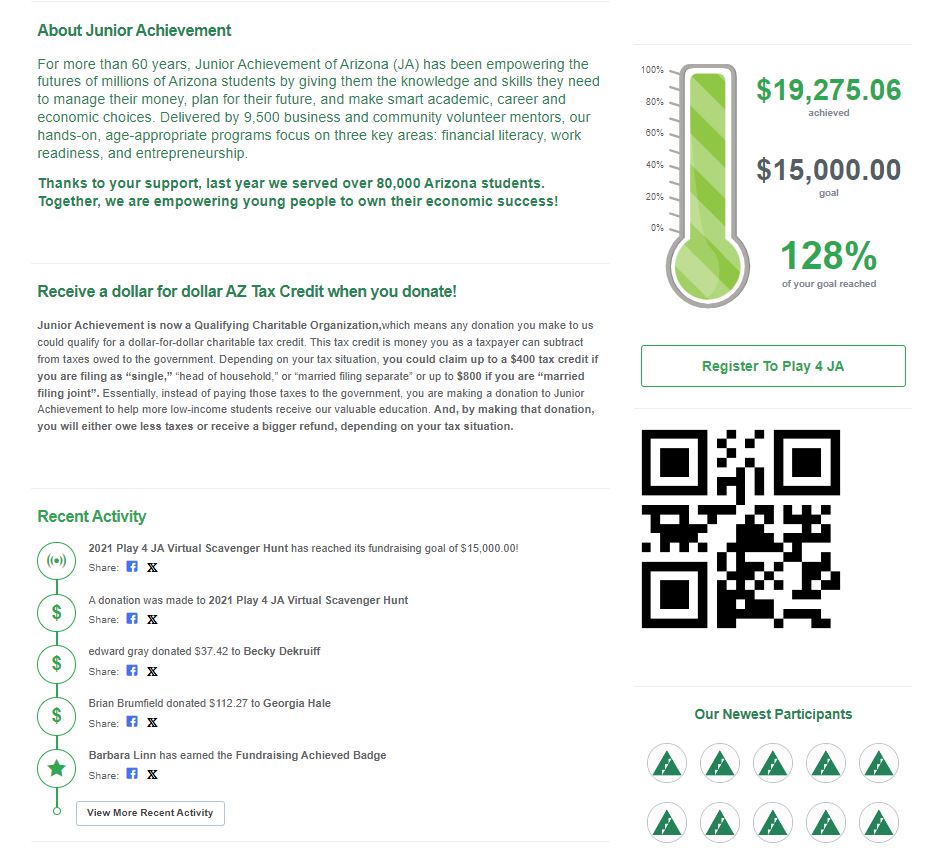
When you’re shopping around for peer-to-peer software, make sure to look for a software solution that is flexible and will grow with your organization’s needs and creativity. You should also find a platform that offers plenty of support and training options for your organization’s staff and leadership.
Not all peer-to-peer software solutions are made the same. Some have a learning curve, so having the proper support is essential for your organization’s fundraising success.
By including all of these features in one package, peer-to-peer fundraising software makes it easy for your nonprofit to run the most efficient and effective campaign possible.
Benefits of using peer-to-peer fundraising platforms
There are many benefits to using this kind of software. Here are the top three:
- Donors always get a receipt and a thank-you note after completing a streamlined donation process.
- Branding your donation page to your organization instills trust that the revenue is going to your nonprofit.
- Fundraisers can easily share their posts and drive traffic to mobile-optimized pages. Mobile-responsive donation pages yield 34% more donations.
Peer-to-peer fundraising software can ensure that your team and your fundraisers have all the tools they need to run a successful campaign.
What is the best fundraising platform?
When you partner with Qgiv for a peer-to-peer fundraising campaign, you’re not just getting our software! We’ll also:
- Train your team to use the software.
- Scale our software to your organization’s growing needs and adapt as you change.
- Give you ongoing support throughout your campaign for troubleshooting, questions, and more.
Features to look for
Using a peer-to-peer fundraising platform to support your campaign can streamline your process by providing features such as:
- Customizable individual participant and team pages
- Marketing tools like social sharing buttons and email tools
- Online merchandise storefront
- Fundraising badges, thermometers, and fundraising leaderboards
- Custom data reporting
- Flexible tools for all fundraiser types
And don’t forget to take advantage of all the other features that our fundraising platform offers!
- Text fundraising: Pairing your peer-to-peer campaign with text fundraising helps your organization reach your participants on the devices they always have with them—their phones. With keywords and automated donation completion reminders, it’s easy for your donors to give on their phones no matter where they are in the world.
- Recurring donations: Allow your peer-to-peer donors to make their donation recurring to encourage a long-term relationship with your organization. Automating recurring donations makes giving to your organization as easy as possible for your donors.
- Gift matching: Provide gift matching opportunities to your donors by allowing them to search for their employer on a gift matching database embedded directly onto your donation form.
- GiftAssist: Give your donors the option to offset processing costs for their gift by adding a small amount to their donation with GiftAssist. Your donors can add the additional amount right from your donation form as they’re completing their transaction.
- Customer experience: Fundraising isn’t easy, but you never have to do it alone! Wondering if you’re using our products to their maximum potential? Want to learn how to up your fundraising game? Our customer experience team is always ready to help you get the most from Qgiv.
How Qgiv can help your peer-to-peer fundraising campaign
Remember the highly successful examples that we showed you earlier? They were powered by Qgiv! Thousands of nonprofits have trusted Qgiv to support their peer-to-peer fundraising campaigns. You can read some of their testimonials here!
Good peer-to-peer fundraising software makes it easy to build a great event page, launch your campaign, and support your participants as they raise money for your cause. With our suite of comprehensive fundraising tools and features, we’ll support you the whole way, from the planning period to the final thank you emails.
Peer-to-peer fundraising FAQs
Here are some common questions people ask about peer-to-peer fundraising!
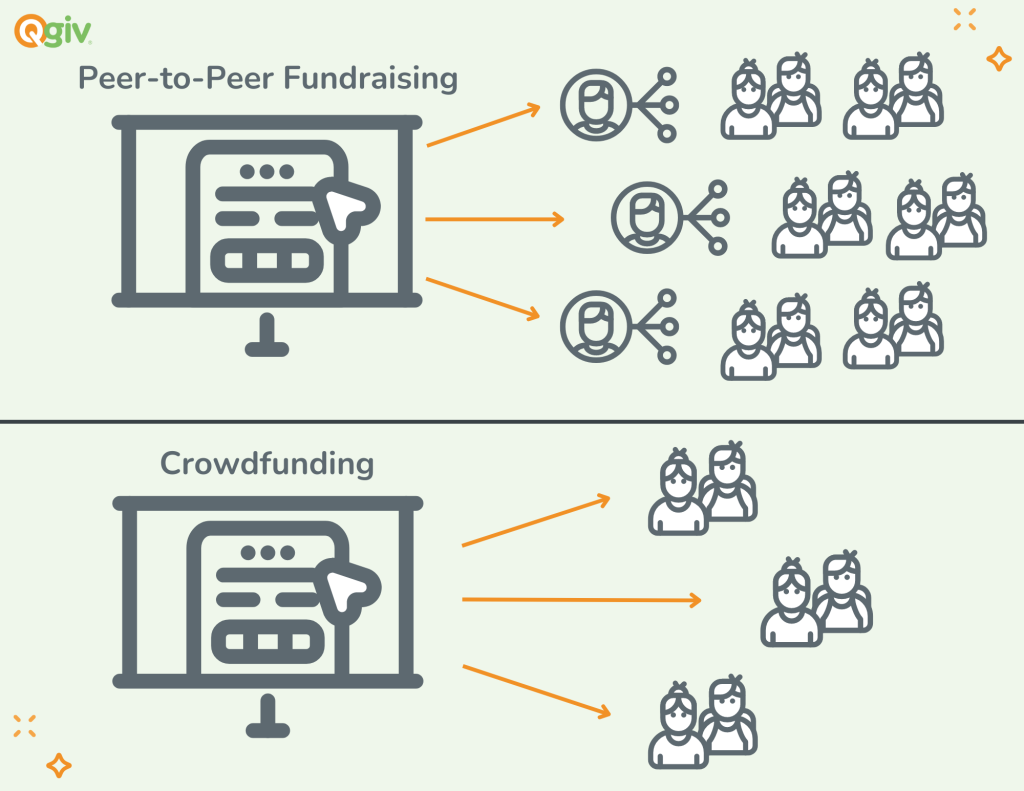
What is the difference between peer-to-peer and crowdfunding?
The biggest difference between peer-to-peer fundraising and crowdfunding is the number of people asking for donations. Peer-to-peer fundraising often has many people asking for donations on behalf of a nonprofit, while crowdfunding is usually one person or group asking as wide an audience as possible for donations.
While peer-to-peer fundraising also relies on donations from multiple donors, your organization can recruit previous donors and volunteers to reach out to their networks and raise money on your behalf. Donation amounts can vary, and pledges can also be accepted. Your participants usually have individual fundraising pages they can collect donations on and work to actively fundraise for your organization—rather than just using casual, word-of-mouth fundraising methods to get the word out.
Crowdfunding is a fundraising method that’s centralized on one fundraising page shared with a large audience. Often, the donation amounts are smaller, and the fundraising campaign relies on word of mouth and social sharing to reach a wide audience.
Both of these methods are handy ways of raising money for your organization! Take time to learn more about the differences between crowdfunding and peer-to-peer fundraising and figure out which method is right for you!
Who can use peer-to-peer fundraising?
Everyone can use peer-to-peer fundraising! You’ve probably already seen or experienced it. When individuals ask for donations or pledges for a 5K or other fitness challenge for a school or cause awareness, that’s peer-to-peer fundraising! Fitness challenges and “athon” events are common peer-to-peer fundraisers that everyone can participate in.
Why does peer-to-peer fundraising work?
Peer-to-peer fundraising campaigns engage your donors by involving them in the fundraising process, which also means it can be very cost effective. Furthermore, it’s easy to combine this fundraising style with other campaigns run on online fundraising platforms, which means there’s tons of room to experiment and grow.
You can use this fundraising method to raise money, of course—but it’s also a valuable way to engage your most loyal supporters! It works because:
- Your supporters can customize their donation pages to reflect their own relationship with your mission, which is a fantastic way to get your supporters thinking about why they value their relationship with you!
- Your staff and supporters work closely together, which is a great way to build stronger relationships with your most engaged fans.
- Donors feel more connected to your nonprofit after personally raising money for it!
- People are more likely to give when asked by a friend or family member.
What kind of peer-to-peer fundraisers make the most money?
The most effective peer-to-peer fundraisers are ones with compelling stories and clear calls to action. Using walkathons and other challenges can help you raise more funds because of their competitive nature that inspires both your participants and donors to hit their fundraising goal. Network and DIY fundraisers are also great at making money because they allow your participants more freedom on how they reach to ask for donations from their networks.
How can I fundraise a lot of money fast with peer-to-peer fundraising?
You can start raising money with peer-to-peer fundraising quickly by preparing for your peer-to-peer campaigns in advance. Prep materials to recruit volunteers, provide them with donation letter templates they can personalize, and create a reasonable goal for the amount of time you have to fundraise to help create a sense of urgency without the goal seeming unreachable.
Final thoughts
Peer-to-peer fundraising is a great way to spread awareness for your mission and further increase your fundraising efforts. You can reach new audiences through your current donors and volunteers in a more personal way. Use fundraising software to make your peer-to-peer campaign easier for both your team and your supporters.
Additional resources
Now that you’re an expert on running peer-to-peer fundraising, check out some of these awesome resources to take your campaigns to the next level.
- 35 Exciting Peer-to-Peer Fundraising Ideas. Want to host a peer-to-peer campaign? It’s time to decide what kind of campaign you want to host. Check out this list of 35 fun ideas to get started.
- 30+ Virtual Peer-to-Peer Fundraising Ideas to Explore. Almost 70% of nonprofits are planning to use virtual elements in events post-COVID. Find out the benefits, plus get virtual event inspiration!
- The Key Peer-to-Peer Fundraising Best Practices for Success. For more tips and tricks on making the most of your campaign, check out our guide and learn more about rocking your peer-to-peer events.






